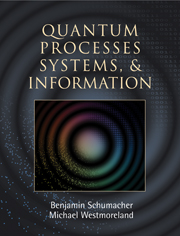Book contents
- Frontmatter
- Contents
- Preface
- 1 Bits and quanta
- 2 Qubits
- 3 States and observables
- 4 Distinguishability and information
- 5 Quantum dynamics
- 6 Entanglement
- 7 Information and ebits
- 8 Density operators
- 9 Open systems
- 10 A particle in space
- 11 Dynamics of a free particle
- 12 Spin and rotation
- 13 Ladder systems
- 14 Many particles
- 15 Stationary states in 1-D
- 16 Bound states in 3-D
- 17 Perturbation theory
- 18 Quantum information processing
- 19 Classical and quantum entropy
- 20 Error correction
- Appendix A Probability
- Appendix B Fourier facts
- Appendix C Gaussian functions
- Appendix D Generalized evolution
- Index
12 - Spin and rotation
Published online by Cambridge University Press: 05 June 2012
- Frontmatter
- Contents
- Preface
- 1 Bits and quanta
- 2 Qubits
- 3 States and observables
- 4 Distinguishability and information
- 5 Quantum dynamics
- 6 Entanglement
- 7 Information and ebits
- 8 Density operators
- 9 Open systems
- 10 A particle in space
- 11 Dynamics of a free particle
- 12 Spin and rotation
- 13 Ladder systems
- 14 Many particles
- 15 Stationary states in 1-D
- 16 Bound states in 3-D
- 17 Perturbation theory
- 18 Quantum information processing
- 19 Classical and quantum entropy
- 20 Error correction
- Appendix A Probability
- Appendix B Fourier facts
- Appendix C Gaussian functions
- Appendix D Generalized evolution
- Index
Summary
Spin-s systems
Angular momentum is one of the fundamental quantities of Newtonian physics, and in quantum physics its importance is at least as great. In quantum mechanics we often distinguish between two types of angular momentum: orbital angular momentum, which a system of particles possesses due to particle motion through space; and spin angular momentum, which is an intrinsic property of a particle. The distinction will be important later, but for now we will ignore it. We will here refer to angular momentum of any sort as “spin” and develop general-purpose mathematical tools for its description.
We have already dealt with spin systems, particularly the example of a spin-½ particle. Our approach began with the empirical observation that a measurement of any spin component of a spin-½ particle could yield only the results +ħ/2 or −ħ/2. We introduced the basis states |z±〉 for the two-dimensional Hilbert space ℋ. We also gave other basis states such as {|x±〉} and {|y±〉} in terms of the |z±〉 states. From basis states and measurement values we constructed operators for the spin components Sx, Sy, and Sz. With the operators in hand, we could then examine the algebraic relations between them (such as the commutation relation in Exercise 3.56).
Our job here is to generalize our analysis to systems of arbitrary spin. To do this, we will reverse our chain of logic.
- Type
- Chapter
- Information
- Quantum Processes Systems, and Information , pp. 247 - 267Publisher: Cambridge University PressPrint publication year: 2010



